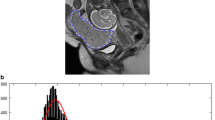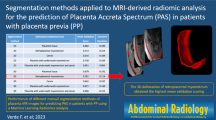Abstract
Purpose
To separately perform visual and texture analyses of the axial, coronal, and sagittal planes of T2-weighted images and identify the optimal method for differentiating between the normal placenta and placenta accreta spectrum (PAS).
Methods
Eighty consecutive patients (normal group, n = 50; PAS group, n = 30) underwent preoperative MRI. A scoring system (0–2) was used to evaluate the degree of abnormality observed in visual analysis (bulging, abnormal vascularity, T2 dark band, placental heterogeneity). The axial, coronal, and sagittal planes were manually segmented separately to obtain texture features, and seven combinations were obtained: axial; coronal; sagittal; axial and coronal; axial and sagittal; coronal and sagittal; and axial, coronal, and sagittal. Feature selection using the least absolute shrinkage and selection operator method and model construction using a support vector machine algorithm with k-fold cross-validation were performed. AUC was used to evaluate diagnostic performance.
Results
The AUC of visual analysis was 0.75. The model ‘coronal and sagittal’ had the highest AUC (0.98) amongst the seven combinations. The fivefold cross-validation for the model ‘coronal and sagittal’ showed AUCs of 0.85 and 0.97 in training and validation sets, respectively. The AUC of the model ‘coronal and sagittal’ for all subjects was significantly higher than that of visual analysis (0.98 vs. 0.75; p < 0.0001).
Conclusion
The model ‘coronal and sagittal’ can accurately differentiate between the normal placenta and PAS, with a significantly better diagnostic performance than visual analysis. Texture analysis is an optimal method for differentiating between the normal placenta and PAS.



Similar content being viewed by others
Abbreviations
- PAS:
-
Placenta accreta spectrum
References
1. Do QN, Lewis MA, Xi Y, et al (2020) MRI of the Placenta Accreta Spectrum (PAS) Disorder: Radiomics Analysis Correlates With Surgical and Pathological Outcome. J Magn Reson Imaging 51:936–946. https://doi.org/https://doi.org/10.1002/jmri.26883
2. Kilcoyne A, Shenoy-Bhangle AS, Roberts DJ, et al (2017) MRI of Placenta Accreta, Placenta Increta, and Placenta Percreta: Pearls and Pitfalls. American Journal of Roentgenology 208:214–221. https://doi.org/https://doi.org/10.2214/AJR.16.16281
3. Jauniaux E, Chantraine F, Silver RM, et al (2018) FIGO consensus guidelines on placenta accreta spectrum disorders: Epidemiology,. Int J Gynecol Obstet 140:265–273. https://doi.org/https://doi.org/10.1002/ijgo.12407
4. Kapoor H, Hanaoka M, Dawkins A, Khurana A (2021) Review of MRI imaging for placenta accreta spectrum: Pathophysiologic insights, imaging signs, and recent developments. Placenta 104:31–39. https://doi.org/https://doi.org/10.1016/j.placenta.2020.11.004
5. Garmi G, Salim R (2012) Epidemiology, Etiology, Diagnosis, and Management of Placenta Accreta. Obstetrics and Gynecology International 2012:1–7. https://doi.org/https://doi.org/10.1155/2012/873929
6. Zaghal AA, Hussain HK, Berjawi GA (2019) MRI evaluation of the placenta from normal variants to abnormalities of implantation and malignancies. J Magn Reson Imaging 50:1702–1717. https://doi.org/https://doi.org/10.1002/jmri.26764
7. Ueno Y, Kitajima K, Kawakami F, et al (2014) Novel MRI finding for diagnosis of invasive placenta praevia: evaluation of findings for 65 patients using clinical and histopathological correlations. Eur Radiol 24:881–888. https://doi.org/https://doi.org/10.1007/s00330-013-3076-7
8. Delli Pizzi A, Tavoletta A, Narciso R, et al (2019) Prenatal planning of placenta previa: diagnostic accuracy of a novel MRI-based prediction model for placenta accreta spectrum (PAS) and clinical outcome. Abdom Radiol 44:1873–1882. https://doi.org/https://doi.org/10.1007/s00261-018-1882-8
9. Oyelese Y, Smulian JC (2006) Placenta Previa, Placenta Accreta, and Vasa Previa. Obstetrics & Gynecology 107:927-941
10. D’Antonio F, Iacovella C, Palacios-Jaraquemada J, et al (2014) Prenatal identification of invasive placentation using magnetic resonance imaging: systematic review and meta-analysis. Ultrasound Obstet Gynecol 44:8–16. https://doi.org/https://doi.org/10.1002/uog.13327
11. Siauve N (2019) How and why should the radiologist look at the placenta? Eur Radiol 29:6149–6151. https://doi.org/https://doi.org/10.1007/s00330-019-06373-8
12. Sato T, Mori N, Hasegawa O, et al (2017) Placental recess accompanied by a T2 dark band: a new finding for diagnosing placental invasion. Abdom Radiol 42:2146–2153. https://doi.org/https://doi.org/10.1007/s00261-017-1100-0
13. Chen E, Mar WA, Horowitz JM, et al (2019) Texture analysis of placental MRI: can it aid in the prenatal diagnosis of placenta accreta spectrum? Abdom Radiol 44:3175–3184. https://doi.org/https://doi.org/10.1007/s00261-019-02104-1
14. Baughman WC, Corteville JE, Shah RR (2008) Placenta Accreta: Spectrum of US and MR Imaging Findings. RadioGraphics 28:1905–1916. https://doi.org/https://doi.org/10.1148/rg.287085060
15. Sun H, Qu H, Chen L, et al (2019) Identification of suspicious invasive placentation based on clinical MRI data using textural features and automated machine learning. Eur Radiol 29:6152–6162. https://doi.org/https://doi.org/10.1007/s00330-019-06372-9
16. Hecht JL, Baergen R, Ernst LM, et al (2020) Classification and reporting guidelines for the pathology diagnosis of placenta accreta spectrum (PAS) disorders: recommendations from an expert panel. Mod Pathol 33:2382–2396. https://doi.org/https://doi.org/10.1038/s41379-020-0569-1
17. Lambin P, Rios-Velazquez E, Leijenaar R, et al (2012) Radiomics: Extracting more information from medical images using advanced feature analysis. European Journal of Cancer 48:441–446. https://doi.org/https://doi.org/10.1016/j.ejca.2011.11.036
18. Gillies RJ, Kinahan PE, Hricak H (2016) Radiomics: Images Are More than Pictures, They Are Data. Radiology 278:563–577. https://doi.org/https://doi.org/10.1148/radiol.2015151169
19. Castellano G, Bonilha L, Li LM, Cendes F (2004) Texture analysis of medical images. Clinical Radiology 59:1061–1069. https://doi.org/https://doi.org/10.1016/j.crad.2004.07.008
20. Do QN, Lewis MA, Madhuranthakam AJ, et al (2019) Texture analysis of magnetic resonance images of the human placenta throughout gestation: A feasibility study. PLoS ONE 14:e0211060. https://doi.org/https://doi.org/10.1371/journal.pone.0211060
21. Romeo V, Ricciardi C, Cuocolo R, et al (2019) Machine learning analysis of MRI-derived texture features to predict placenta accreta spectrum in patients with placenta previa. Magnetic Resonance Imaging 64:71–76. https://doi.org/https://doi.org/10.1016/j.mri.2019.05.017
22. Blaicher W, Brugger PC, Mittermayer C, et al (2006) Magnetic resonance imaging of the normal placenta. European Journal of Radiology 57:256–260. https://doi.org/https://doi.org/10.1016/j.ejrad.2005.11.025
23. Chen X, Shan R, Zhao L, et al (2018) Invasive placenta previa: Placental bulge with distorted uterine outline and uterine serosal hypervascularity at 1.5T MRI – useful features for differentiating placenta percreta from placenta accreta. Eur Radiol 28:708–717. https://doi.org/https://doi.org/10.1007/s00330-017-4980-z
24. Horowitz JM, Berggruen S, McCarthy RJ, et al (2015) When Timing Is Everything: Are Placental MRI Examinations Performed Before 24 Weeks’ Gestational Age Reliable? American Journal of Roentgenology 205:685–692. https://doi.org/https://doi.org/10.2214/AJR.14.14134
25. Lax A, Prince MR, Mennitt KW, et al (2007) The value of specific MRI features in the evaluation of suspected placental invasion. Magnetic Resonance Imaging 25:87–93. https://doi.org/https://doi.org/10.1016/j.mri.2006.10.007
26. C Nioche, F Orlhac, S Boughdad, S Reuzé, J Goya-Outi, C Robert, C Pellot-Barakat, M Soussan, F Frouin, and I Buvat. LIFEx: a freeware for radiomic feature calculation in multimodality imaging to accelerate advances in the characterization of tumor heterogeneity. Cancer Research 2018; 78(16):4786-4789 https://doi.org/https://doi.org/10.1158/0008-5472.CAN-18-0125
27. Landis JR, Koch GG (1977) The Measurement of Observer Agreement for Categorical Data. Biometrics 33:159. https://doi.org/https://doi.org/10.2307/2529310
28. Song J, Hu Q, Ma Z, et al (2021) Feasibility of T2WI-MRI-based radiomics nomogram for predicting normal-sized pelvic lymph node metastasis in cervical cancer patients. Eur Radiol. https://doi.org/https://doi.org/10.1007/s00330-021-07735-x
29. Alhamzawi R, Ali HTM (2018) The Bayesian adaptive lasso regression. Mathematical Biosciences 303:75–82. https://doi.org/https://doi.org/10.1016/j.mbs.2018.06.004
30. Mori N, Abe H, Mugikura S, et al (2021) Discriminating low-grade ductal carcinoma in situ (DCIS) from non-low-grade DCIS or DCIS upgraded to invasive carcinoma: effective texture features on ultrafast dynamic contrast-enhanced magnetic resonance imaging. Breast Cancer. https://doi.org/https://doi.org/10.1007/s12282-021-01257-6
31. Dai H, Bian Y, Wang L, Yang J (2021) Support Vector Machine-Based Backprojection Algorithm for Detection of Gastric Cancer Lesions with Abdominal Endoscope Using Magnetic Resonance Imaging Images. Scientific Programming 2021:1–8. https://doi.org/https://doi.org/10.1155/2021/9964203
32. Zhang M-H, Ma J-S, Shen Y, Chen Y (2016) Optimal classification for the diagnosis of duchenne muscular dystrophy images using support vector machines. Int J CARS 11:1755–1763. https://doi.org/https://doi.org/10.1007/s11548-015-1312-0
SAS Institute Inc. 2019. JMP® 15 Predictive and Specialized Modeling. Cary, NC: SAS Institute Inc. https://www.jmp.com/getstarted
34. Srisajjakul S, Prapaisilp P, Bangchokdee S (2021) Magnetic Resonance Imaging of Placenta Accreta Spectrum: A Step-by-Step Approach. Korean J Radiol 22:198. https://doi.org/https://doi.org/10.3348/kjr.2020.0580
35. Jha P, Pōder L, Bourgioti C, et al (2020) Society of Abdominal Radiology (SAR) and European Society of Urogenital Radiology (ESUR) joint consensus statement for MR imaging of placenta accreta spectrum disorders. Eur Radiol 30:2604–2615. https://doi.org/https://doi.org/10.1007/s00330-019-06617-7
36. Bour L, Placé V, Bendavid S, et al (2014) Suspected invasive placenta: evaluation with magnetic resonance imaging. Eur Radiol 24:3150–3160. https://doi.org/https://doi.org/10.1007/s00330-014-3354-z
Acknowledgements
This study has received funding by JSPS (Japan Society for the Promotion of Science) KAKENHI 18K07742.
Funding
JSPS KAKENHI 18K07742.
Author information
Authors and Affiliations
Corresponding author
Ethics declarations
Conflict of interest
The authors have no conflict of interest to disclose.
Ethical approval
This study was approved by the Institutional Review Board (IRB) of Tohoku University Hospital, Sendai, Japan.
Consent to participate
Informed consent was waived.
Additional information
Publisher's Note
Springer Nature remains neutral with regard to jurisdictional claims in published maps and institutional affiliations.
Supplementary Information
Below is the link to the electronic supplementary material.
Rights and permissions
About this article
Cite this article
Ren, H., Mori, N., Mugikura, S. et al. Prediction of placenta accreta spectrum using texture analysis on coronal and sagittal T2-weighted imaging. Abdom Radiol 46, 5344–5352 (2021). https://doi.org/10.1007/s00261-021-03226-1
Received:
Revised:
Accepted:
Published:
Issue Date:
DOI: https://doi.org/10.1007/s00261-021-03226-1




